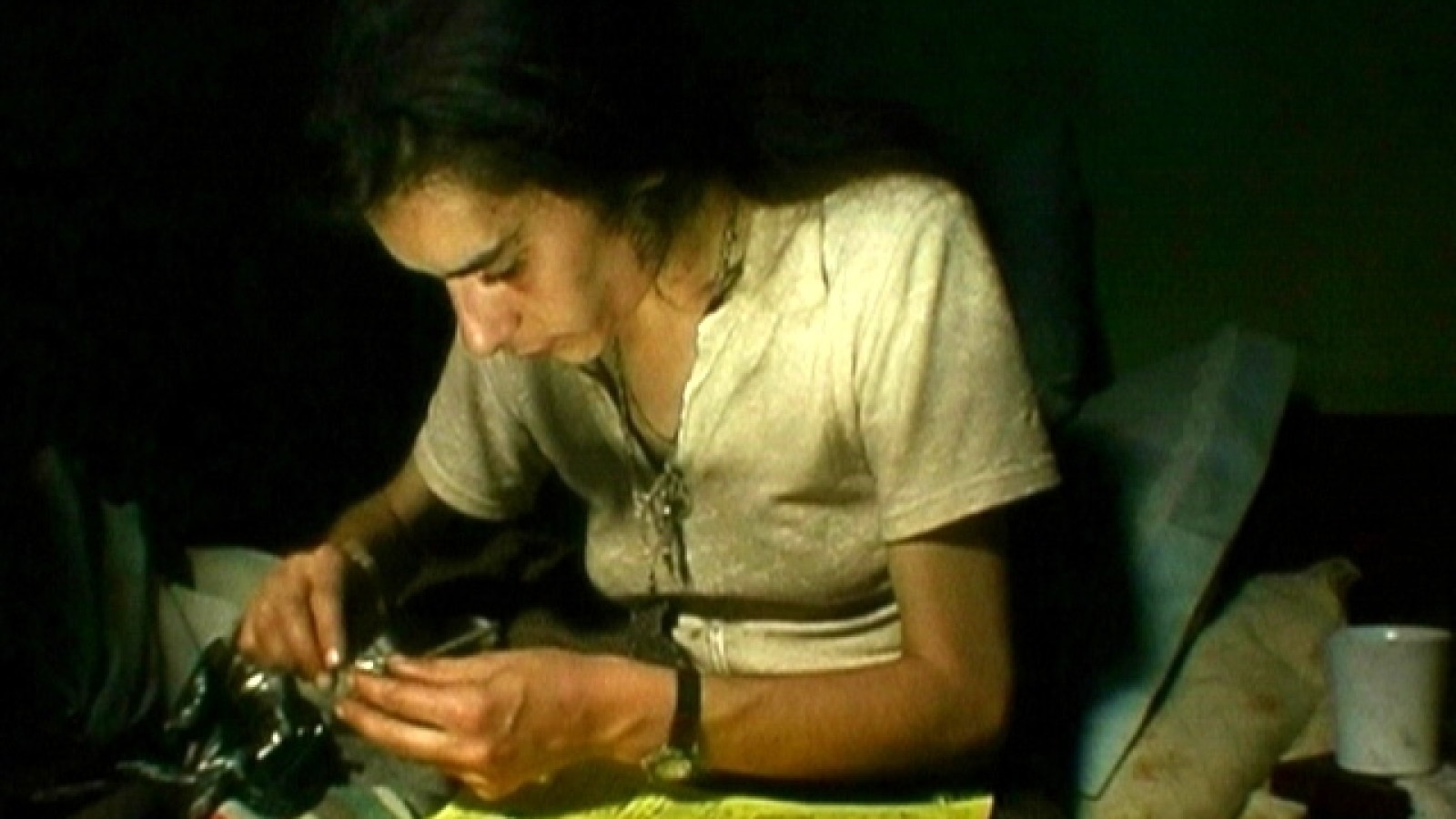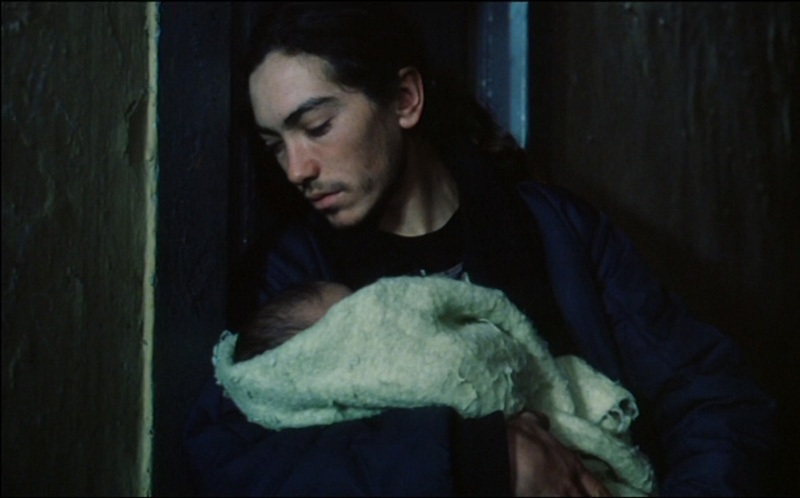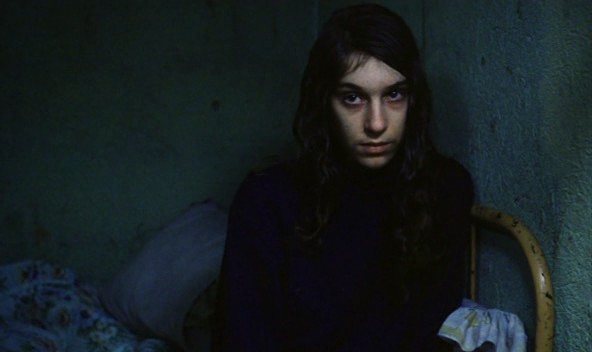No Quarto da Vanda (In Vanda’s Room) by Portuguese director Pedro Costa was shown in Paris and Deca-Fëmijët, Kosovo 2000 (Children – Kosovo 2000) by Ferenc Moldovànyi in Nyon. Both films touched a nerve in their depictions of brutal, naked reality and gave rise to discussions on ethics in documentary filmmaking.
No Quarto da Vanda centres on Vanda Duarte, a young woman living in the slums of Lisbon. When Vanda is not out selling vegetables, she spends most of her time smoking and sniffing drugs in her room, alone or together with her sister Zita. During the three-hour-long film, we witness human destruction at close range, metaphorically sustained by the gradual destruction of the surrounding buildings.
ANETTE OLSEN asked Suzette Glenadel, Director of Cinema du Réel, about her motives for selecting the film for the festival.
AO: Why did you select “In Vanda’s Room” for Cinéma du Réel?
SG: How could such a film not have been selected for a film festival entitled ‘Cinéma du Réel’ (Real Cinema), which is dedicated to social documentaries?
Was it right to enter the film in the competition? The question is legitimate since the film stands out against the ordinary. In fact it bears a closer resemblance to fiction than documentary and bears no likeness to any of the films usually entered in the competition at the festival. Moreover this was the only question I asked myself since I was totally enthralled by its subject and form.
I watched the film late at night and was entranced by it till early morning. And I felt like showing this film to as many people as possible. This truly is art and a type of film that should be seen more often.

AO: The film seems to have hit a nerve by sparking discussions on ethical questions on what is morally acceptable to film and what is not. What are your feelings about that?
SG: In order to answer your second question regarding the debates and ethical questions arising, or which have arisen, from this film, I would firstly like to say that on a personal level this film posed no ethical problem. I find Pedro Costa incredibly respectful of Vanda’s image; some scenes may come close, but he never oversteps the mark. He does not expose Vanda, and the coughing scene, which for some is unbearable, is somehow admissible thanks to the intense familiarity that develops between Vanda and myself the viewer.
If this shot, as all the shots in the film (I will discuss this later), were not as long then nobody would be able to find fault. The aspects of the film that might meet with disapproval are the form, aesthetic quality and slow rhythm, aspects that are reminiscent of the religious or sacred sphere.
We hear endless complaints about the formats imposed by television, the standardization of dealing with subjects and the absence of creativity. Yet we would do away with a strong and original work that deservingly breaks free of these very faults!
I am even more surprised when I realize most documentary professionals praise the short films shown in the Strip Tease [1]Strip Tease is a magazine program made up of small documentary fifteen-minute segments. It is produced in Belgium (originated by Marco Lamench and Jean Libon for RTBF) and has been broadcast on FR3 … Continue reading slot that in my opinion usually pose serious ethical problems.
AO: Did the scenes of shooting and sniffing drugs affect you?
There are actually very few scenes showing someone shooting up drugs: one with Vanda or her sister, and even then it is very discreet, and another time with one of her friends. However not to see Vanda while she is taking drugs would have been strange since she spends most of her time smoking or sniffing, which is to a certain degree the subject of the film. (There have already been films with addicts injecting drugs into their arms as the only subject, something that is far more sensational.)

AO: The film is beautifully shot. What do you think of the way the scenes are ‘aesthetisized’, i.e. the light, the composition?
SG: The lighting is certainly beautiful, in the style of Flemish painting, and certain shots are true canvases worthy of the old masters, but again it is obvious that there is a play of shadow and light in the narrow alleyways of the ghetto from which the camera cannot escape. If this is the lighting that lights up and highlights the face and world of Vanda, why should it be forbidden?
The images chosen to enhance and transcend poverty also allow the filmmaker to restore dignity to the characters and compel us to respect them.
The film is not there to make a show of this poverty, but rather to give us the opportunity to grasp reality by ourselves by being immersed in Vanda’s world. It is demanding on the viewer and requires very special attention—which also accounts for the strong rejection.
AO: There is a strong and clear-cut metaphor in showing the destruction of buildings parallel to the human destruction due to drugs. To some this is regarded as a heavy-handed way to convey the message. What is your opinion?
SG: You are a talented director, you shoot in a neighbourhood where buildings are being demolished, in the midst of bulldozers and debris from falling houses (let’s not forget the soundtrack), but because you are surrounded with misery, should you be expected to stay away from this environment and not indulge in this metaphor?
Personally, I don’t feel the metaphor is heavy-handed. On the contrary, I find it’s brought about in a rather subtle way!
Reality isn’t altered, and as a filmmaker you have the right to look at a crane or a falling wall with the eyes of an artist. I don’t know if you remember, but there is a moment of great beauty when a dipper persistently ‘attacks’ a wall, and as the wall yields it falls like a human being. It dramatizes the situation, but in a way that is more true to reality than the use of certain kinds of music to accompany tragic moments that are so often heard in documentaries and which don’t shock anybody…
Staging is necessary in the work of an “auteur” or in a creative documentary. When I see a film, I am aware of the fact that it is filtered through the subjectivity of the director. If a documentary shows me the same raw reality that I can see with my own eyes, the film doesn’t interest me. This is the big difference between reportage and the immediate raw reality of a news program. Without speaking about the works of Pedro, documentary films borrow more and more from the style of fiction films.
AO: The film is three hours long – is this necessary?
SG: It is true that during the three hours there is little progression in the storyline. The film, which deals with exclusion and poverty of which Vanda is the emblematic figure, leaves it to us to piece together the story like a puzzle using what we learn from phrases, snatches of narrative, other people, which weave the web of daily life off camera full of drama and hopelessness.

However we are faced with life, extremely precarious of course, but life from which love is not absent. Love is represented through the mother, silent yet always present, who goes to prison to see her other daughter and who provides her with the things she needs despite everything else. Love is also embodied in the relationships between Vanda and her friends, relationships that are not totally indifferent, and finally illustrated through the filmmaker’s love for the characters in the film.
Returning to the subject of the film’s length, it is certainly accentuated by the fact that the film only consists of very long shots (123 shots, I believe, over three hours and ten minutes of film). It is also significant that Pedro Costa filmed in this room using his small digital camera over a period of more than two years. As a consequence, he collected hours and hours of footage. It must be difficult to edit two years of life down to sixty minutes. I think his choice for the length of film appears to be right, give or take a quarter of an hour.
Although the length of this film may evoke disapproval from some viewers, it works by contrast for others and enables them to empathize with Vanda in her deep, drugged hell.
With his minimalist and radical approach, not unlike those of Alain Cavalier (some scenes are strongly reminiscent of Thérèse) or Alexander Sokurov, Pedro Costa has created a work of art that will stand out as a landmark in the history of documentary filmmaking.
References
| ↑1 | Strip Tease is a magazine program made up of small documentary fifteen-minute segments. It is produced in Belgium (originated by Marco Lamench and Jean Libon for RTBF) and has been broadcast on FR3 for several years. |
|---|




